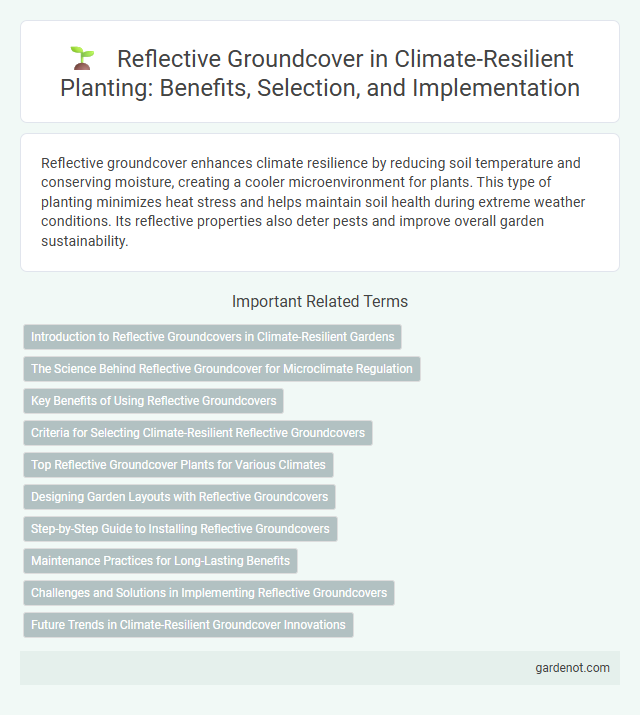Reflective groundcover enhances climate resilience by reducing soil temperature and conserving moisture, creating a cooler microenvironment for plants. This type of planting minimizes heat stress and helps maintain soil health during extreme weather conditions. Its reflective properties also deter pests and improve overall garden sustainability.
Introduction to Reflective Groundcovers in Climate-Resilient Gardens
Reflective groundcovers play a crucial role in climate-resilient gardens by reducing soil temperature and conserving moisture, which helps plants withstand heat stress and drought conditions. These groundcovers, often characterized by their light-colored or silvery foliage, increase sunlight reflection, thereby lowering ambient temperatures around plant roots. Integrating reflective groundcovers like lamb's ear (Stachys byzantina) or silver carpet (Dymondia margaretae) enhances garden resilience against extreme weather while promoting healthier plant growth.
The Science Behind Reflective Groundcover for Microclimate Regulation
Reflective groundcover plays a crucial role in microclimate regulation by reflecting solar radiation away from the soil surface, thereby reducing heat absorption and lowering ambient temperatures. Studies show that materials with high albedo, such as white or silver mulches, can decrease soil temperature by up to 5degC, enhancing moisture retention and reducing plant heat stress. This scientific approach supports climate-resilient planting by creating favorable growing conditions that mitigate extreme heat effects on crops.
Key Benefits of Using Reflective Groundcovers
Reflective groundcovers enhance climate resilience by reducing soil temperature and conserving moisture, which supports plant health during heat stress and drought conditions. Their high albedo properties reflect sunlight, lowering the heat load on surrounding plants and minimizing water loss. Implementing reflective groundcovers improves microclimate stability and promotes sustainable water use in climate-adaptive landscaping.
Criteria for Selecting Climate-Resilient Reflective Groundcovers
Selecting climate-resilient reflective groundcovers requires evaluating species for high albedo properties to reduce soil temperature and mitigate heat stress. Prioritize drought tolerance, rapid coverage, and deep root systems to promote soil moisture retention and erosion control under variable climatic conditions. Disease resistance and adaptability to local soil types enhance long-term sustainability and ecosystem resilience in changing environments.
Top Reflective Groundcover Plants for Various Climates
Reflective groundcover plants like white clover, creeping thyme, and silver ponyfoot enhance climate resilience by reducing soil temperature and conserving moisture across diverse environments. These species improve energy efficiency in hot regions by reflecting sunlight, while their drought tolerance supports sustainability in arid climates. Incorporating reflective groundcovers promotes healthier soil ecosystems and mitigates heat stress in urban and agricultural landscapes.
Designing Garden Layouts with Reflective Groundcovers
Designing garden layouts with reflective groundcovers enhances microclimate regulation by bouncing sunlight onto nearby plants, increasing photosynthesis and growth. Groundcovers like white gravel, glass mulch, or light-colored stones reduce soil temperature, improving moisture retention and resilience against drought. Strategic placement around heat-sensitive plants supports climate-resilient planting by mitigating heat stress and promoting sustainable garden ecosystems.
Step-by-Step Guide to Installing Reflective Groundcovers
Install reflective groundcovers by first preparing the soil with proper leveling and removing debris to enhance reflectivity and promote healthy plant growth. Secure the reflective material using landscape staples or pins, ensuring tight coverage to minimize heat absorption and soil moisture loss. Regularly inspect and maintain the groundcover by cleaning and repairing any damage to optimize its effectiveness in climate-resilient planting systems.
Maintenance Practices for Long-Lasting Benefits
Reflective groundcovers enhance climate-resilient planting by reducing soil temperature and conserving moisture, thus promoting plant health. Regular monitoring of groundcover density and timely trimming prevent overgrowth, ensuring optimal light reflection and air circulation. Proper maintenance practices, including seasonal debris removal and pest management, extend the groundcover's effectiveness and longevity in diverse environmental conditions.
Challenges and Solutions in Implementing Reflective Groundcovers
Implementing reflective groundcovers faces challenges such as high initial costs and limited availability of suitable materials that effectively reduce soil temperature and moisture loss. Solutions include developing cost-effective, durable materials with optimized albedo properties and integrating local plant species compatible with reflective mulches to enhance climate resilience. Ongoing research on adaptive installation techniques and community-based programs can improve adoption rates and long-term sustainability of reflective groundcovers in climate-resilient planting.
Future Trends in Climate-Resilient Groundcover Innovations
Reflective groundcover technology is advancing with the introduction of ultraviolet-reflective coatings and adaptive pigmentation, enhancing plant resilience to extreme heat and solar radiation. Research from the International Journal of Plant Sciences highlights nanomaterial applications that improve soil moisture retention and reduce surface temperature by up to 15%. Emerging trends also include bioengineered groundcovers with increased albedo effect, optimizing microclimate regulation in drought-prone landscapes.
Reflective groundcover Infographic

 gardenot.com
gardenot.com